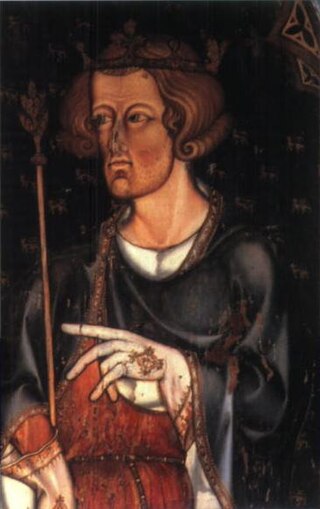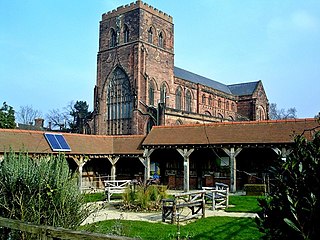Related Research Articles

Over is an ancient borough, mentioned in the Domesday Book, now a part of Winsford in the Cheshire West and Chester district, in the ceremonial county of Cheshire, England. Wharton forms the eastern part, the boundary being the River Weaver. It is said to have retained its borough status and to be the smallest borough in England.
Tarvin is a village in the unitary authority of Cheshire West and Chester and the ceremonial county of Cheshire, England. It had a population of 2,693 people at the 2001 UK census, rising to 2,728 at the 2011 census, and the ward covers about 17 square miles (44 km2).
Vale Royal Abbey is a former medieval abbey and later country house in Whitegate, England. The precise location and boundaries of the abbey are difficult to determine in today's landscape. The original building was founded c. 1270 by the Lord Edward, later Edward I, for Cistercian monks. Edward had supposedly taken a vow during a rough sea crossing in the 1260s. Civil wars and political upheaval delayed the build until 1272, the year he inherited the throne. The original site at Darnhall was unsatisfactory, so was moved a few miles north to the Delamere Forest. Edward intended the structure to be on a grand scale—had it been completed it would have been the largest Cistercian monastery in the country—but his ambitions were frustrated by recurring financial difficulties.

Combermere Abbey is a former monastery, later a country house, near Burleydam, between Nantwich, Cheshire and Whitchurch in Shropshire, England, located within Cheshire and near the border with Shropshire. Initially Savigniac and later Cistercian, the abbey was founded in the 1130s by Hugh Malbank, Baron of Nantwich, and was also associated with Ranulf de Gernons, Earl of Chester. The abbey initially flourished, but by 1275 was sufficiently deeply in debt to be removed from the abbot's management. From that date until its dissolution in 1538, it was frequently in royal custody, and acquired a reputation for poor discipline and violent disputes with both lay people and other abbeys. It was the third largest monastic establishment in Cheshire, based on net income in 1535.

Richard Brooke or Broke was an English landowner and navy officer.

Darnhall Abbey was a late-thirteenth century Cistercian abbey at Darnhall, Cheshire, founded by Lord Edward sometime in the years around 1270. This was in thanks, so tells the Abbey's chronicler, for God saving him and his fleet from a storm at sea. It was dedicated to St Mary. It only existed for a short time before it moved to the better-known Vale Royal Abbey. The site chosen for the Abbey at Darnhall was discovered to be unfit for its purpose. Money was short, as Edward did not provide enough for the original foundation, but the Abbey was allowed to trade wool to augment its finances. The Abbey relocated a few miles north, and what remained of Darnhall Abbey became the monastic grange of the new foundation. There was probably only ever one Abbot of Darnhall before the Abbey relocated in 1275.

Thomas Prestbury was an English medieval Benedictine abbot and university Chancellor.

The recorded abbots of Shrewsbury run from c 1087, four years after Shrewsbury Abbey's foundation, to 1540, its dissolution under Thomas Cromwell. The abbey was large and well-endowed and the abbots were often important political figures as well as ecclesiastical leaders. They varied greatly over the centuries in ethnic and social origins, intellectual attainments and holiness of life. The first two, Fulchred and Godfred, were imported from Normandy. The remainder seem to have been born in Britain and most, but not all, were elected, or at least selected, from the chapter of the abbey. As important territorial magnates, the abbots were always called to take part in the sessions of Parliament from its very beginnings as an institution in 1265. As important figures in the Western Catholic Church, abbots were permitted by the Pope to wear the pontifical ring from 1251 and the mitre from 1397.

Eia or Eye was an early medieval manor in Westminster, Middlesex and is now a part of Central London. It was about one mile west of the Palace of Westminster/Whitehall, about 2 miles west-south-west of the walled City of London, and about half a mile north of the River Thames.
In the early fourteenth century, tensions between villagers from Darnhall and Over, Cheshire, and their feudal lord, the Abbot of Vale Royal Abbey, erupted into violence over whether they had villein—that is, servile—status. The villagers argued not, while the Abbey believed it was due the villagers' feudal service.
John Chaumpeneys was the last Abbot of Darnhall Abbey and first Abbot of Vale Royal Abbey, Cheshire, from around 1275 to circ 1289.
Walter of Hereford was a twelfth- and thirteenth-century Abbot of Vale Royal Abbey in Cheshire. He was Abbot from around 1294 to approximately 1307. His abbacy occurred at a time of tribulation for the abbey, mostly due to poor relations with the local populace. Walter is in portrayed in his Abbey's later chronicler in superlatives. He is described as "greatly venerable in life and always and everywhere devoted to God and the Blessed Virgin Mary" and as
A man of most beautiful appearance, as regards externals...and in good works also he fought a good fight for Christ, for he used a hair shirt to conquer the flesh, and by this discipline subdued it to the spirit. He rarely or never ate meat.
John of Hoo was an early fourteenth-century Abbot of Vale Royal Abbey, Cheshire. His abbacy was from around 1308–09 to 1314–15.
Richard of Evesham was Abbot of Vale Royal from 1316 to 1342.
Peter was an English Cistercian abbot who served as the fifth abbot of Vale Royal Abbey, Cheshire, in the first half of the 14th century. He is generally held to be the author of the abbey's own chronicle, which was published in 1914 as the Ledger of Vale Royal Abbey. Owing to a failure to finish the abbey's building works—which had commenced in 1277 and had been intermittently ongoing ever since—the abbey was unsightly, and the monks' quarters probably near derelict. Abbot Peter oversaw the transplantation of the house onto new grounds. Much of his career, however, was focussed on defending his abbey's feudal lordship over its tenants. The dispute between the abbey and its tenantry had existed since the abbey's foundation; the abbot desired to enforce his feudal rights, the serfs to reject them, as they claimed to be by then freemen. This did not merely involve Abbot Peter defending the privileges of his house in the courts. Although there was much litigation, with Abbot Peter having to defend himself to the Justice of Chester and even the King on occasion, by 1337 his discontented villagers even followed him from Cheshire to Rutland. A confrontation between Abbot Peter and his tenants resulted in the death of a monastic servant and his own capture and imprisonment. With the King's intervention, however, Abbot Peter and his party were soon freed.
Robert de Cheyneston was Abbot of Vale Royal Abbey, Cheshire between 1340 and 1349. De Cheyneston had already been a monk at the Abbey before his election as Abbot.
Thomas Ragon was the eighth Abbot of Vale Royal Abbey, Cheshire. His term of office lasted from 1351 to 1369. His abbacy was predominantly occupied with recommencing the building works at Vale Royal—which had been in abeyance for a decade—and the assertion of his abbey's rights over a satellite church in Llanbadarn Fawr, Ceredigion, which was also claimed by the Abbot of Gloucester.
John was Abbot of Vale Royal Abbey, Cheshire, between 1405 and 1411, and although his abbacy seems to have been largely free of the local disorder that had plagued those of his predecessors, the Abbey appears to have been taken in to King Henry IV's hands on at least two occasions.
Vale Royal Abbey is a medieval abbey, and later a country house, located in Whitegate, between Northwich and Winsford in Cheshire, England. During its 278-year period of operation, it had at least 21 abbots.
Sir Nicholas Atherton (c.1357-1420) of Atherton. Other titles; Nicholas de Atherton, Lord of Bickerstaffe. English politician and Member of parliament (MP) of the Parliament of England for Lancashire in 1401. A lifelong member of affinity who was knighted on the 27 October 1400 in York, and prorogued on 20 January 1401 in Westminster. Born into a position within the Lancashire gentry. Extensive service to the House of Lancaster. Bailiff and medieval tax collector.
References
- 1 2 3 Knowles & Smith 2008, p. 342.
- 1 2 3 4 V. C. H. 1980.
- ↑ Ormerod 1819, p. 72.
- ↑ Ormerod 1819, p. 82.
- ↑ Baines 1836, p. 661.
- ↑ Collins 1812, p. 244.
- ↑ Brownbill 1914, pp. 83–92.
- ↑ Brownbill 1914, p. 138-49.
- ↑ Brownbill 1914, p. 24-37 n.13.
- ↑ M. E. D. 2001.
Sources
- Baines, E. (1836). History of the County Palatine and Duchy of Lancaster. Vol. III. London: Fisher, son & Company.
- Brownbill, J., ed. (1914). The Ledger Book of Vale Royal Abbey. Manchester: Manchester Record Society.
- Collins, A. (1812). Collins's Peerage of England: Contains the earls from the accession of George III. Vol. V. London: F.C. and J. Rivington, Otridge and Son, J. Nichols and Company ... [and 26 others].
- Knowles, D.; Smith, D. M. (2008). The Heads of Religious Houses: England and Wales, 1377-1540. Vol. III. Cambridge: Cambridge University Press. ISBN 978-0-521-86508-1.
- M. E. D. (2001). "Middle English Dictionary Entry". University of Michigan.
- Ormerod, G. (1819). The history of the county palatine and city of Chester: compiled from original evidences in public offices, the Harleian and Cottonian mss., parochial registers, private muniments, unpublished ms. collections of successive Cheshire antiquaries, and a personal survey of every township in the county; incorporated with a republication of King's Vale royal, and Leycester's Cheshire antiquities. London: Lackington, Hughes. Harding, Mavor, and Jones.
- V. C. H. (1980). Elrington, C. R.; Harris, B. E. (eds.). "Houses of Cistercian monks: The abbey of Vale Royal". Victoria County History. A History of the County of Chester, III. London.